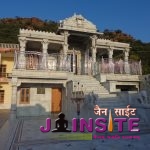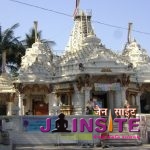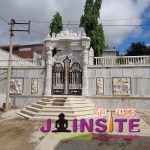SHRI KSHATRIYAKUND TIRTH
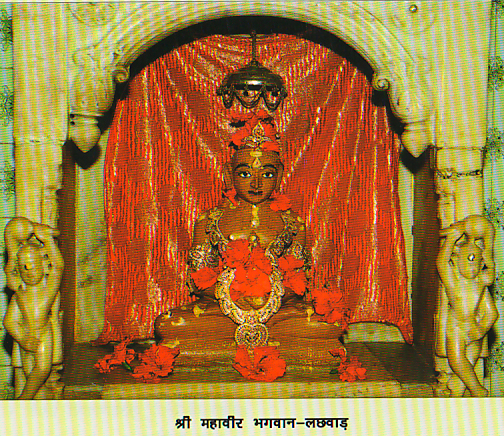
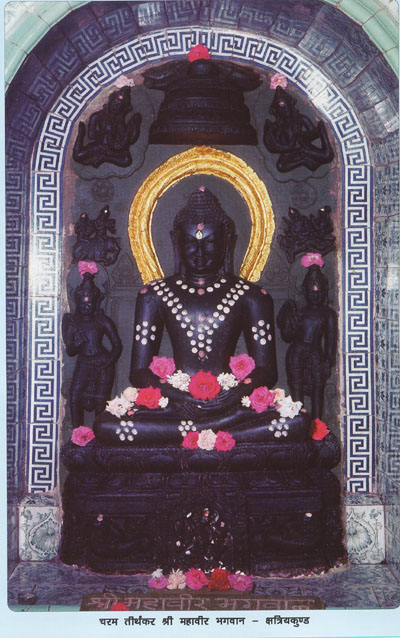
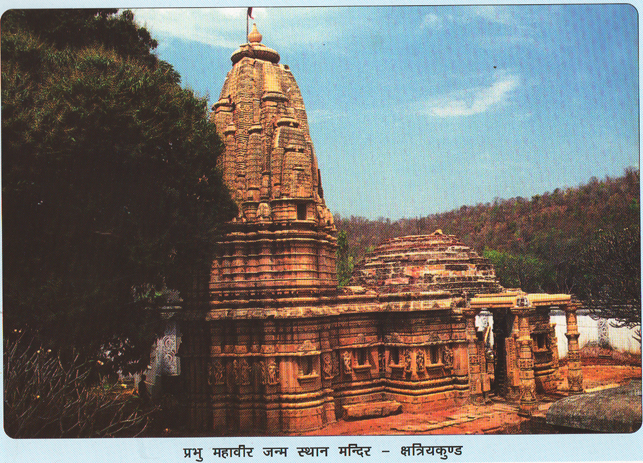
PRESIDING DEITY AND LOCATION :
Sri Lord Mahavir Bhagwan seated in a lotus posture in black color and of height about 60cms, in a shrine 5kms away from Kundghat, the base of Kshatriyakund, on the top of thickly wooded hills (Shve.)
ANTIQUITY AND SALIENT FEATURES :
History of this shrine commences in the pre Mahavir period. Lord Mahavir’s father was king Siddhartha of Gyata dynasty and Kshatriyakund was their capital town. King Siddhartha had married King Chetaka’s sister Trishala and King Chetaka was the chief of the democratic republic of Vaishali (Digamber tradition believes Trishala to be the daughter of King Chetak) and a follower of Lord Parshvanath. King Chetak had vowed that his daughters to be married to only Jain Kings.
King Siddhartha was a very popular, peace-loving and religious- minded king. Near his city of Kshatriyakund, there existed another city, by the name of Brahmakund where lived Rishabhadatt whose wife’s name was Devananda. On Ashadh Sukla 6 in the constellation of Uttarashadh, Devananda had magnificent dreams suggestive of a unique event. That very moment the soul of Lord Mahavir after completing his 26 births took the form of an embryo and entered the womb of Devananda. When Devananda and Rishabhadatt learnt about the meaning of these dreams, they as parents felt overjoyed and their family started growing in prosperity every day.
However, according to Jain traditions, it is considered necessary that the great souls who are to be Tirthankaras in their final incarnations have to be born in the Kshatriya clan. In the case of Lord Mahavir it is believed that because in one of his previous births as Marichi he had developed intense pride, he had to atone for being born in another clan. When therefore the embryo of Lord Mahavir entered the womb of Devananda, the Lord of the heavens Saudharmendra Deva considered that embryo must immediately be transplanted into the womb of Trishala of the Kshatriya class. He accordingly ordered Naigameshi Deva to effect the transplant, which was doe on Ashadh Sukla 13 in the same Uttarshadh constellation. Now as soon as the transplant was effected, mother Trishala had the dreams indicative of the birth of Tirthankar. (Digambar Jains do not accept this embryo transplant).
After completing nine months and seven and half days of conception, mother Trishala at midnight of Chaitra Sukla 13 in the Vikram Samvat 543 B.C. gave birth to a baby boy with Ionine characteristics. As part of celebrations in heavens, the chief of Gods, Indra and his associates managed to keep a substitute with Mother Trishala and whisked away the boy to Meru Mountain for celestial bathing and anoinment. A great festival was held there with éclat and pomp and the boy was returned without knowledge of anyone on earth. In king Siddhartha’s kingdom, sweets and presents were freely distributed and prisoners were released. There was a veritable wave of happiness and joy in the hearts of common men, women and children of the land. With the birth of this boy food crops became plenty, peace became wide and deep and happiness in the general atmosphere became evident and lasting. From the 12th day people named Mahavir as Vardhaman, ever growing. (According to Digamber traditions Lord Mahavir was born at Vasukund in Vaishali or at Kundalpur near Nalanda.
Sri Vardhaman was both brave and fearless from childhood. Once upon a time, when as a child, he was playing the game of tree-climbing with other children of his age, one of the Devas assumed the form of a serpent and like a creeper surrounded the tree. Sri Vardhaman saw this and in one single sweep of his hand, taking hold of the serpent he separated it from the tree. The same Deva took the form of a child , joined in the game and lost in it. He had to allow someone to ride on him as a horse would. As soon as Sri Vardhaman rode on him he changed himself into a colossal and frightening animal and started running at the speed of wind. The lord hit him severely only with his fists and the Deva became quiet and respectfully bowed. Sri Vardhaman was not only physically fearless and brave but also was of an exceptional caliber. This is revealed in the dialogues carried on by him with his teachers in the school during the questions he was asked.
Lord Mahavir despite being unwilling to marry married only to please his parents, Yashodadevi daughter of King Samavir. (According to Digamber traditions the Lord remained to celibate throughout his life). In the course of time Sri Yashodadevi gave birth to a daughter who was named Priyaarshana and who later married Jamali, a prince, son of Sudarshana the Lord’s sister, When Mahavir became 28 years pf age, King Siddhartha and Queen Trishala, his parents, died and Nandivardhan, the elder brother became the King. Mahavir’s heart was not in the temporal affairs of the world. He was always pensive and deeply thoughtful. Brother Nandivardhan, after being requested several times, at last consented to Mahavir’s renunciation. Mahavir cheerfully giving up his kindly comforts and with a smile distributing all his wealth and possessions took diksha by discarding all his personal clothing and by plucking all his hair in only five hand plucks in the royal garden known as “Gyatkhand” on Magsar Krishna Dasami in the year 513 B.C. At that very moment Mahavir became endowed with the 4th type of knowledge described in Jain parlance as Manah Paryaya Gnana (knowledge by direct access to the minds of others). Mahavir was at this time, hardly 30 years old. When Lord Mahavir discarded all of his personal clothing, Indra Bhagwan presented the Deva Dusya cloth.
Mahavir suffered manyu hardships after diksha until the end of his physical life but by his fearlessness and compassion, purity, endurance and erudition he set a remarkable personal example and gave freshness to the universal religion of man.
In Kalpa-Sutra by Bhadrabahu over two thousand years ago, a detailed description of Kshatryakund as the birth place of Lord Mahavir is given. In 1352 A.D. on being inspired by Sri Jinachandrasuriji, valchak rajshekarji, Subuddhirajji, Hemtilak Ganiji, Punyakirti gain and others had visited Badgaon (Nalanda) and several householder Jains including Badgaons chief Ratnapla with their families had gone on a pilgrimage to Kshatriyakund and adjacent shrines, all this is described in Pradhanacharya Gurvavali . In the15th century , Acharya Sri Lohatitacharyasuriji had been to Kshatriyakund and other places, this is referred to by Sri Jinodayasuriji in one of his writings. The description of Kshatriyakund is also found in the composition relating to shrines of the east made by Sri Jinavardhasuriji in the year 1467 A.D. In Dashacaikalika Vriti a reference is found to the pilgrimage made to this shrine by learned Sri Jayasagaripadhyayaji in the 16th Century. Even muni Sri Jianaprabhasuriji in his “Tirthmala” has described Kshatriyakund. In “Tirthmala” composed by Kavi Hanssomvijayji in 1565 A.D this Kshatriyakund is described. In the 18th Century, Sri Shilavijayji has referred to this place in his beautiful language. In 1750 Sri Saobhagyavijayji has described this place in his holy “Tirthmala”. Thus it is evident that this holy place has been described on various occasions during the last two and half thousand years since the birth of Lord Mahavir. Today, however , on the top of hills this is the only shrine which is called “Lord’s birth place”. Near about there are many ruins which remind one of the places such as Kumargram, Mohankundgram, Brahmankundgram, Morak and others.
At the base of the hills, there are two temples which are known as places of Chyavan Kalyanak and Diksha Kalyanak.
This shrine of Kshatriyakund is particularly unique because it was at this place that Lord Mahavir was conceived, born and initiated – three events of the Panch kalnayak in the life of Lord Mahavir had taken place. The five events are conception, birth, Initiation, attainment of Perfect Enlightenment and liberation(Chyavan, Janma, Diksha, Keval Gnan, and Moksha respectively). What words therefore can adequately express the sanctity and importance of it?
Not only the temple at the spot of the birth alone but every dust particle of this land on which Lord Mahavir tread two and a half thousand years ago is holy and reverent. Even today, the cool and peaceful atmosphere of this place generates springs of devotion in the hearts of men and women who visit it. Everyone on reaching the place becomes completely forgetful of his common and worldly chores and gets deeply absorbed in transcendental thoughts. It was here that the Lord first felt a powerful and incontrollable urge for self-liberation and universal welfare. It was said that at this period of time in human history, several evil forces had gathered strength on the name of religion innocent lives were being sacrificed, women were considered mere chattels and the system of holding men and women under slavery was gaining momentum. Weak and helpless men and women were being sold in the open market and one who possessed or owned more slaves was considered highly respectable and great. Lord Mahavir’s soul rebelled against these practices and in order to find everlasting happiness for mankind and all life, he preferred the way not only of self-liberation but also of universal welfare. He after severe austerities, study and contemplation extending over a period of twelve years obtained Kewal Gnan and began preaching principles of non-violence, non-falsehood, non-stealing, non-covetousness and self-continence. Even today, the necessity of observing these principles is keenly felt by humanity at large. The Lord also proclaimed women as equals of men and gave them a right to preach religion. He abolished caste distinctions and advised love and compassion for all forms of life including even plantean, insectan and bacterial.
Here the ancient idol of Lord Mahavir is both beautiful and looking cheerful. At the very sight of the idol, one’s soul is gladdened. From the base of hill, about 5kms away the natural scenery on the hills is most captivating.
At present this is the only temple on the top of Kshatriyakund hills. At the base there are two small temples where Lord’s idols have been installed. In Lachhwad, there is one temple. All these are Swetamber temples.
APPROACH ROUTE :
Nearest railway station are Lakshsarai, Jamui and Kiyul,all about 30Kms from Lachhawad from where buses and taxis are available. Lachhawas is about 10 Kmsaway fro Sikandara. From Lachhawad, the base of the hill viz Kundghat is 5Kms away and from there Kshatriyakund is another 5Kms away. In Lachhawad, there is a dharamshala, which is about half kilometer from the bus stand, where taxis and autos are available. Buses and cars can go up to Kundghat. From there one has to climb only by foot to Kshatriyakund.
AMENITIES FOR JAIN PILGRIMS :
In Dharamshalas Lachhawad, all the facilities are available including a bhojanshala for meals. On the hills at Kshatriyakund,resting rooms are available with water facility.
MANAGED BY :
The Jain Swetamber Society
P.O. Lachhawad – 811 315.
Dist : Jamui (Bihar)
Ph : 06345- 22361.


